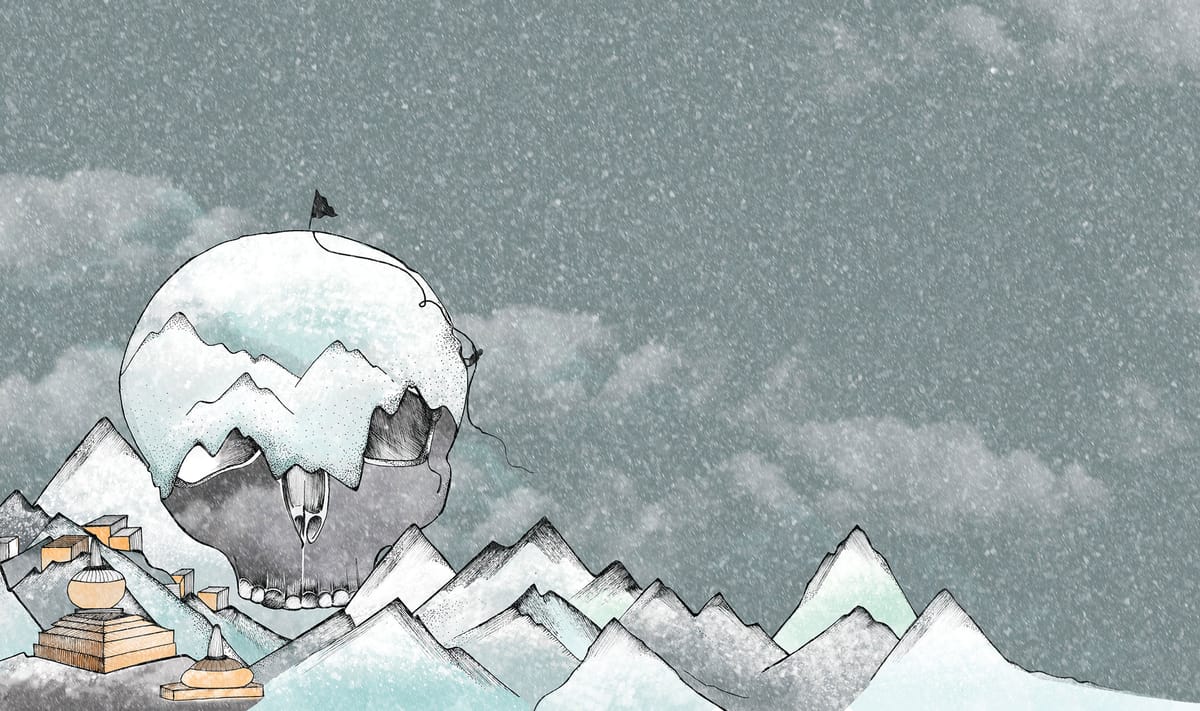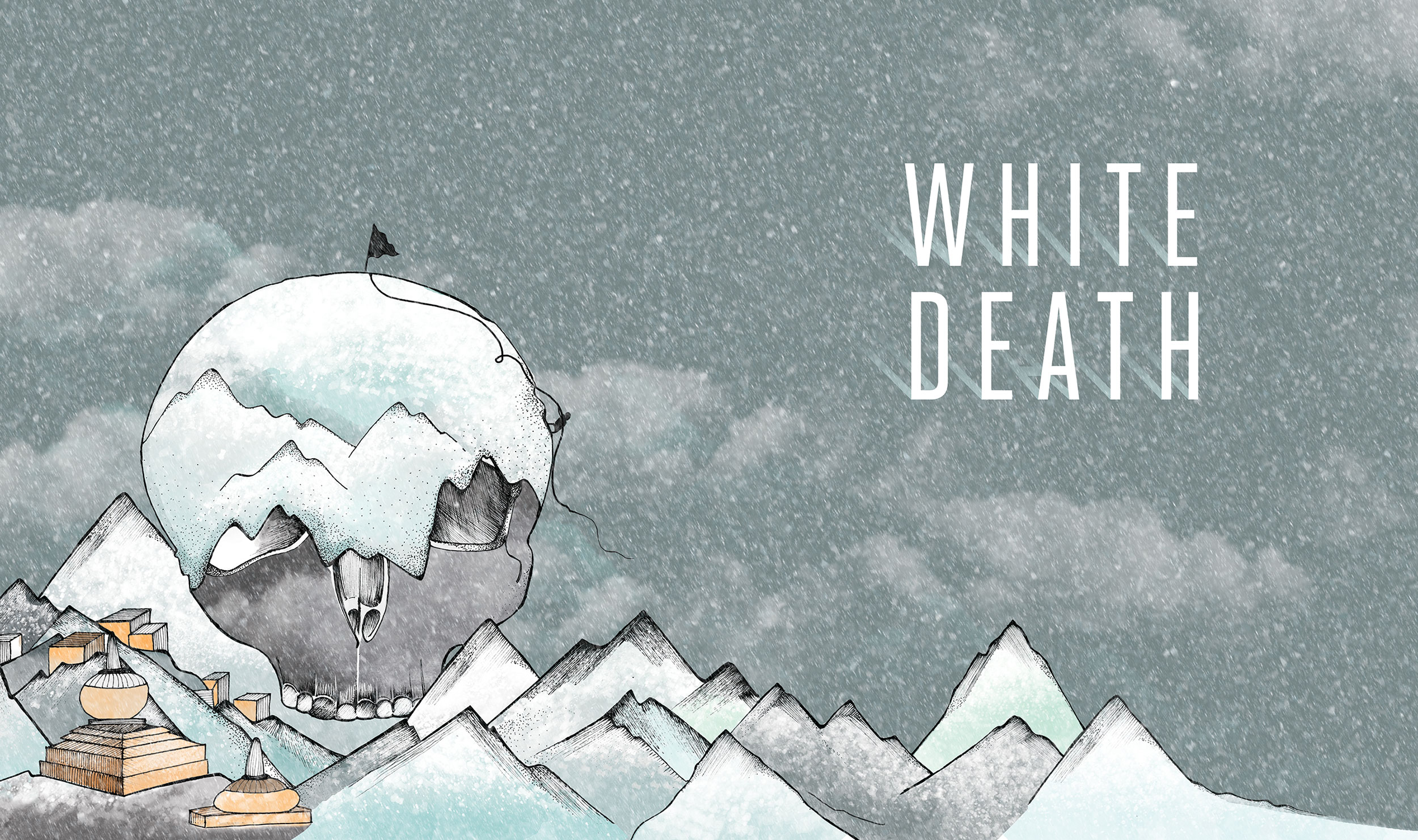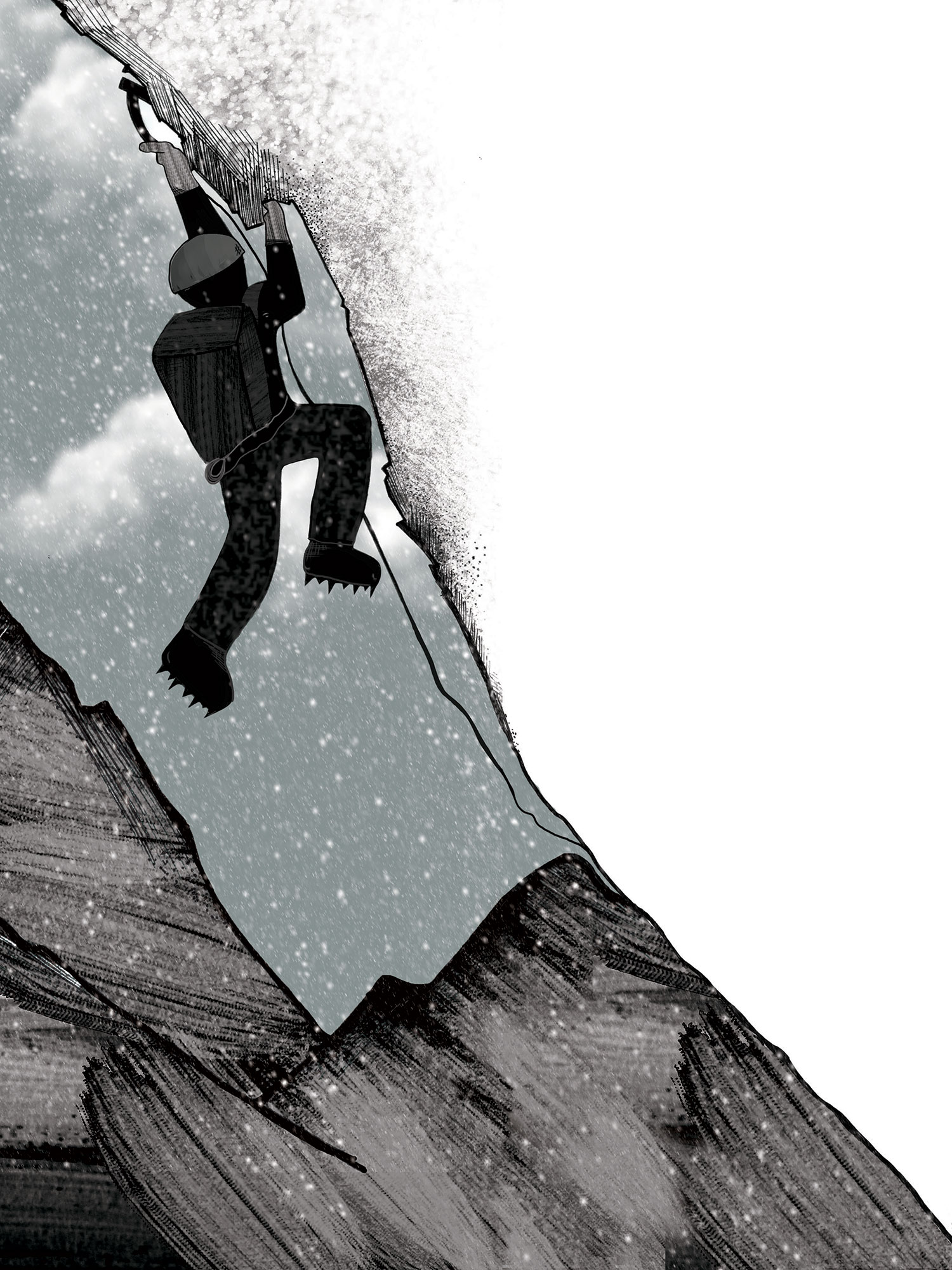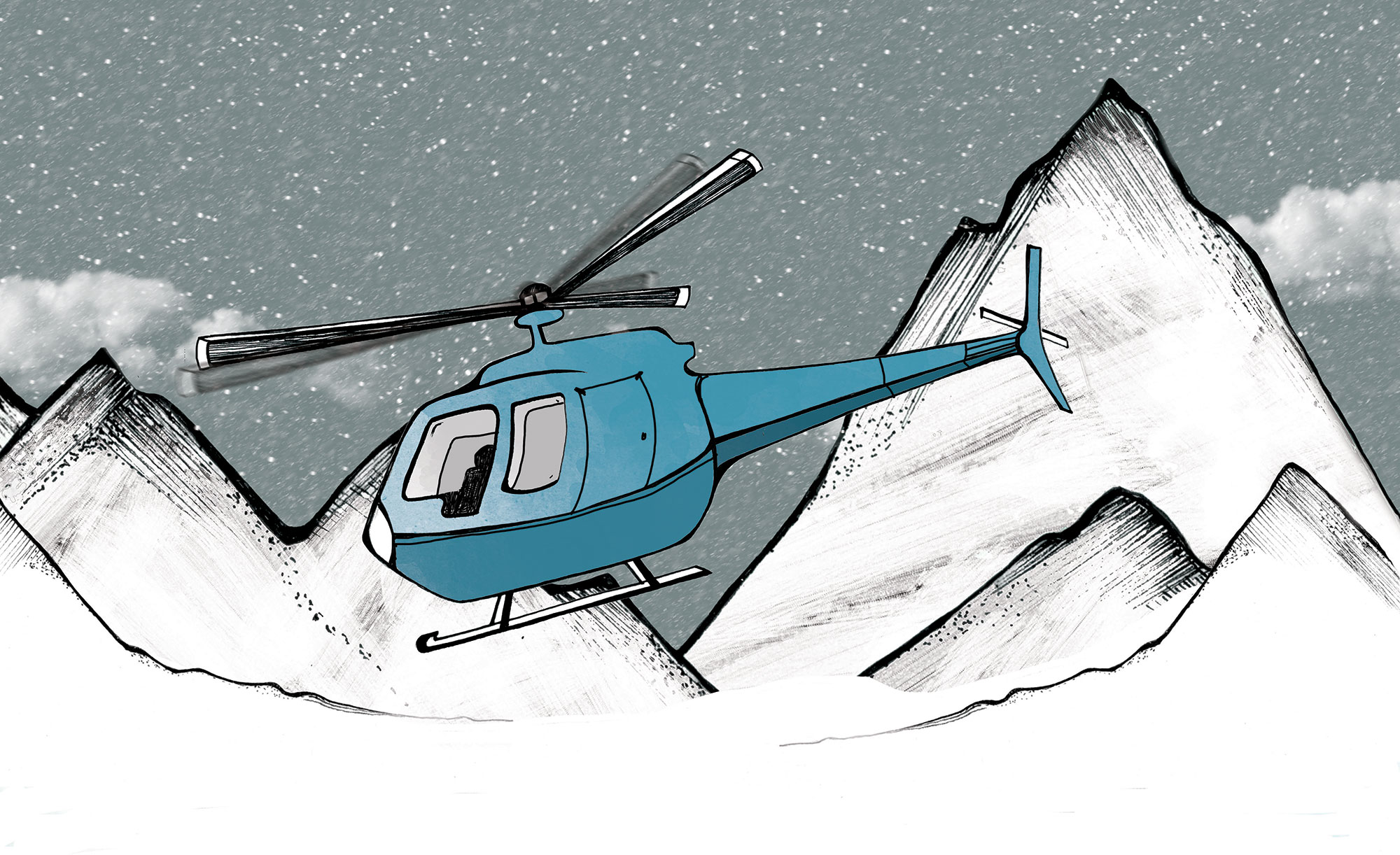White Death
Galvanised by their 6,000-meter ascent, a party of climbers disregard the most basic safety rule. The rescue worker is well reputed, but up there, life hangs by a thread.

This story originally featuring in the Spring 2014 print issue and was translated by Amy Turk.
It is eight in the morning and I’m still in my bed. At this point in my life, I live in a small village outside Manali, a Himalayan town that serves as the gateway to the region’s more remote areas. Outside, though it’s June, it is calm and very cold. Temperatures have recently plummeted due to some major and unforeseen snowfall that has covered the nearby summits. As things go up here, these are particularly “shitty” conditions. The cell phone beside my bed begins to buzz.
It’s Rajeev Sharma, the Assistant Director of the High Mountain Institute in Manali. He’s also my friend. This morning his voice is serious. “We just had a climbing party disappear into thin air at the top of Chithi Dhar. That’s the one located to the right of Friendship Peak, above Solang Valley, you know the one?”
It’s a 5100-meter high peak and a nasty one.
“I don’t really know more, but it appears to be bad, yes. Another party travelling behind them tipped me off. That team has radio contact with the base camp at Dhundi. They are going to update me as quickly as they can, but I need you right away. I don’t have anyone else qualified on hand at the moment. Where are you? Can you come? How can we get you up here?”
Lying there in bed, I take a deep breath, then get up, blink, and begin preparing for one of the most treacherous days I would face in my former job as a mountain rescue expert in the Himalayas.

In a few minutes, I’ve thrown on my protective gear. My wife and daughters are awake now. They are used to seeing me leave on rescue missions. We all know I might never return. Each operation is unique, risky in a way that’s difficult to calculate in advance. One has to be willing to accept every possible outcome, and I am.
By the time the rescue operation is underway, we have to move quickly. People in my line of work operate on the bare minimum. Without much detailed information or time to consult maps, we rely heavily on split-second decisions.
Rajeev Sharma, my counterpart, is a member of a limited group in India. There are very few high mountain rangers like him, especially here in the Himalayas. He knows and respects the mountain. He is, plain and simple, the most qualified Indian mountaineer I’ve met. In addition to many Everest climbs, he’s taken part in countless expeditions on all four corners of the globe. We share the same passion and sense of responsibility. We know that we can count on one another. This is important because, in a rescue operation above 3000 meters, the team members’ lives and the mission’s success depend on impeccable communication.
Fifteen minutes after Rajeev’s call, I am at my office with my two bags. The first one is equipped with my evacuation triangles, an extensive first aid kit, a rope, my crampons, two ice axes and so on. The second contains my sleeping bag in its waterproof cover, a cooking stove, and rations to spare in case things don’t go as planned and I have to spend the night on a glacier. We take off without a word and I’m immediately aware of the heavy atmosphere inside the vehicle.
“Who’s the client?” I ask.
“A Japanese guy. He left with a guide and three sherpas seven days ago, and everything was apparently going well. It seems the accident happened when they reached the summit.” Rajeev answers.
“Ok, I’ve got to get to base camp right away. How many are going with me?”
“Four”
“They’re all qualified and well-equipped?”
“Uh, well, not exactly, Jean-Luc!”
“What? What good are the others going to do me if they don’t have the right equipment and don’t know what they’re doing?”
Right then, I realize that I will be able to count on no one but myself for any kind of technical support. We reach the based camp, located at 2700 meters, in a couple of minutes. From there, I get a radio and continue on my own to the advanced base camp. At an altitude of 3500 m, this camp is situated between the edge of the Solang Valley and the foot of Mount Hanuman Tibba. My breath adjusts itself to the considerable effort I’m asking of my heart. Fortunately, the adrenaline has been pumping through my veins for several long minutes by now. Even so, it takes an hour and a half of continuous brisk hiking to reach advanced base camp and by then it is already 11 am.

There I meet the Guide of the unfortunate party. She is beside herself and collapses in my arms. Her words trembling, she explains the accident. Experienced and well trained, she is not unnecessarily dramatic. Her client was the president of a Japanese Alpine club and also a friend of hers. Everything was going well. The weather conditions had been breathtaking, despite the excessive snow. They had reached the summit without issue, an especially impressive feat as her client was also over 65.
“For several days, we progressed steadily,” she began. “My client was being cautious, but always moving forward. When we arrived at the summit, we were all very happy. We took photos to celebrate our victory and then, all of a sudden, he decided to detach himself. I refused, insisting it was too dangerous, but I quickly rescinded, because after all, he had 35 years of experience. He was very well respected by the others and I’d climbed with him often, all over the Himalayas.”
In her recollection, she drew upon her trust in him and helped him untie himself from the group. He then decided to call his son. This climb was to be the crowning achievement in his career as a mountain climber and Himalayan enthusiast. It would also mark his retirement. After the call to his son, he made another to Rajeev Sharma and in so doing, managed to move away from the group by barely a couple dozen centimetres, and out onto a ledge. Before he even realized it, the ground fell out from under him and he dropped down the steep and rocky north face. His body bounced from one rocky outcropping to the next before ending its fatal trajectory on a glacier, some 1500 meters below.
The team was in shock. The deadly blow was dealt in a fraction of a second, and no one could fully fathom it. The other party, who had witnessed the fall from below, wanted to try and reach the victim with first aid. Their throats tight, they hiked back down the summit’s crest, hoping to find a possible point of access. They all gave their absolute best, particularly their young leader, who after much effort could do no more than take photos from afar of the body lying there in the snow.
It sweeps tiny particles of snow over the sight of the tragedy like white death.
Without specially adapted materials, rappelling down such a steep, rocky wall is practically impossible. The team didn’t want to risk a second accident. After returning to the summit, they convinced the first guide that her client’s chances of survival were infinitesimal and that rescue was impossible. A heavy silence descended over the two groups. With no alternative, they returned to camp as quickly as possible, all silent, except for the minimal utterances needed for the technical aspects of their downward descent.
As she finishes telling the story, we look out over the valley. The wind picks up, blowing hard. It sweeps tiny particles of snow over the sight of the tragedy like white death.
Back at camp, the young guide of the second group shows me the photos he took. It's easy to see that the climber would be in at least a critical state, but most likely already dead. I grab the radio.
“Radio Control, Titli here. Do you copy me? Over.”
“Copy, Titli, Go ahead!”
“The photos show the client on the North Face of the Lahaul side. Reaching him on the ground from above is impossible. Request for immediate aerial backup. Over.”
“Ok! Stay in position and wait for further instructions. Over.”
A few minutes pass.
“Titli, radio control here. You have immediate orders to return to base camp. Over and Out.”
When I get there, I find a Jeep waiting for me. We don’t waste any time. In a mere 35 minutes, we have made the bumpy ride down from camp and reach the road that will take us to the nearby military base.
As soon as we arrive, Captain Randhir Singh Saluria, director of the High Mountain Institute, and Colonel Rajesh Seth, head of the military base, take me aside. Colonel Seth tells me, “First of all, thank you for your expeditious aid in this matter. That being said, I’m afraid we have a problem. Foreigners, such as yourself, are not allowed inside the confines of the base without the expressed authorization of the Minister of the Armed Forces. I am sorry. I did, however, request a military helicopter and permission to transport you. Please remain on hand and await further information.”
The driver takes me back outside the gate of the base. I am frustrated by this delay in my rescue. I think back to the times I had interacted with the victim myself. I had talked to him many times, about his climbs, and about the exploits of the younger generations. I try to relax, to just accept the administrative side of the rescue process and its slowness. After two hours of waiting and still no helicopter on the horizon, an officer comes to see me.
“You can enter the base now. The Colonel had received word from the Minister of Defense, Sir R.K. Anthony. Please come quickly.”
“The Minister? Where are the helicopters?” I ask.
Before I know it, I’m in the hangar, in front of the helicopter pad. The Colonel is there, waiting for me.
“Sir, thank you for allowing me back into the base and for accepting my services,” I begin, “but where are the helicopters? Will there be a team with me?”
“The helicopters are on their way. They had to make a stop to fill-up on kerosene. They should be here any minute. What kind of rescue operation are you envisioning?”
I answer him, slightly bitter, “An initial flight will be necessary in order to determine his exact position and to take some aerial photos. From there we can plan our intervention. In any case, the victim is certainly deceased by now. He fell more than 7 hours ago and the temperatures are in the neighbourhood of -15⁰C up there. His chances of survival are pretty much nonexistent. So, I think we have a little time.”

The noise of the two helicopters can be heard throughout the valley. One will be used to evacuate the victim and the other will come along for support. The pilots, the mechanical engineers, and I make a quick plan for the operation. The chief pilot officer fills us in on our short window of suitable meteorological conditions.
“We’ll need to take the doors off the helicopters"
I explain that the body is lying at an altitude between 4200m and 4500m, on a glacier on the north face of the Lahaul slope. Agreeing to a reconnaissance flight, the pilot says, “We’ll need to take the doors off the helicopters, and remove a seat from each and empty half of each tank. We have to be light. ” He looks at me appraisingly, “Are you also coming with us?”
Here the director of the Institute, Captain Randhir Singh Saluria interjects. “Yes, Mr Joubert will lead this mission. He is the only one capable of this type of operation. We don’t have anyone trained in helicopter rescue at the Institute. Please, hurry!”
The only way to access the victim’s location is to fly over Rohtang Pass (3936m), due north, then veer west and follow a high rocky stretch for 15km before descending to follow the glacier north until we find the body. The long, high-altitude flight requires that the helicopter is as light as possible.
I address the officer. “Sir, I have two bags. One weighs 15 kg and is for the rescue. The other is 18 kg and has my survival supplies. Their total weight is around 35 kg, sir.”
“Ok, but you will be on your own. I can’t take anyone else and if the weather takes a turn for the worse while you’re out there, we’ll have to return to base. You will stay on the glacier tonight and we will come back for you at first light.”
I am no stranger to this type of situation. I’ve spent the night on glaciers over 4000m high many times before and I know I can handle it. I’ll have radio contact with base camp, like an umbilical cord, my only link to the outside world. I won’t be able to transmit at the frequency used by the military pilots for reasons of national security. In the case of an emergency, I will call base camp, which will then retransmit my message to the military base, which will, in turn, notify my pilot.
We lay out our plan of entry and decide on time-saving hand signals to use in place of communicating every little detail by radio. I grab my two bags, get in, and we take off, rising out of the valley and across Rohtang Pass. From here, I have a breath-taking view of the Himalaya, but before I know it, we’ve arrived at our designated spot. The pilot motions that he will now fly down and graze the area so I can take photos of the victim and assess the glacier’s structure. It is now clear that the Japanese climber is in fact deceased. His location is difficult for me to read. He’s sprawled across a series of interconnected crevasses. I can’t decide on a jump that will get me close to the body without landing me at the bottom of one of these deadly cracks. I brace myself for the worst. I explain to the pilot that many of the crevasses are filled with snow and therefore difficult to identify. I need a second look, so he turns us around to get us back in position, while the second copter hovers in place, waiting. I make my determination and then say to the pilot, “Can we circle back once more? Get as close as you can and then I’ll make my jump.”
“Alright. Once you’re down there, you’ll have 7 minutes before we’ll have to head back, in which case you will stay the night.”
“Ok. I’m ready.”
I try not to think of anything other than the essential steps I need to follow. The helicopter flies as low as it can before the blades hit snow. The pilot gives me the sign to jump. My heart is beating fast. I am more than 5m from the ground. I am well aware of the danger should I jump into an undetectable crevasse or onto a snow peak that breaks apart on impact. It’s an icy, high altitude game of Russian roulette. My glacial rescue instructor always told me to throw my rescue pack first, then my survival bag, as a test. If they didn’t fall through, then I would most likely make it, too.
“Go, go, I’m going to let you loose!” yells the pilot.
I don’t think, I just jump on top of my sacks, my two ice axes in hand, crampons on my feet, ready for anything. I get a good grip, lying on my two packs, keeping them with me. Seeing that all is well, the helicopter ascends, covering me with pulverized snow in the process, before vanishing into the vast white landscape.
I am all alone. My GPS reads 4557m. I take a deep breath and reassure myself. I look up and see the body sprawled some 20m ahead of me. I look at my watch. I only have 5 minutes left. I have to act fast. I don’t want to stay the night. I get on my knees and start moving forward, sending my bags out first, one after the other. I reach the body, which is completely dislocated and entirely frozen. It’s horrific. The skull is in 1000 little pieces. The arms and legs point every which direction. I act mechanically, by reflex. There is no room for emotion, only precise action.
In general, during a rescue, I remain very alert even though it feels like I’m on autopilot. Assessing the corpse, it’s clear I have no choice but to further break each one of the victim’s limbs so that he fits into the mesh harness. He needs to be as compact as possible or we risk losing him in flight. I carefully place his hat around his head to keep it all in place and then fasten his helmet on top. I collect all of his belongings within reach and then I signal using my radio that I am ready. I have just over a minute left, according to my watch. I receive the double beep, which means OK in rescue language, but it doesn’t tell me anything about the position of the helicopters.
Alone and cold, and seated next to death, I await evacuation. I scan the horizon in vain. Then suddenly, a sound, distant at first, grows into a deafening roar. I can only see one helicopter, and it hovers above me and lowers the rescue cable to which I attach the evacuation harness. I signal to the pilot all clear. I sit back on my packs and cover my head. Technically this is a very dangerous moment because the snow whips around violently, pelting the face. Only 3m overhead, the helicopter’s blades are very close, and the noise, combined with that of the engine, is terrible. The helicopter leaves once again, dangling the body as it disappears into the immense white. I remain alone. My evacuation helicopter is nowhere in sight.
I look out in the direction of the Baralacha La Pass and see that it is totally obstructed from view. The weather is changing fast. It’s getting bad. I wonder if they’re coming for me or not. I start mentally preparing myself to spend the night. I try to call base again. Nothing. Three interminable minutes go by before I see the second helicopter appear. It’s a huge relief to know I’m going back. The second pilot comes in very close to me and lowers one side of the vessel to position a landing skid directly over my head. I throw my two packs into the cabin and grab onto the skid. As I bring my legs up around it too, the helicopter backs out and I’m now flying through thin air like a pig hog-tied to a spit.
I grasp at the inside of the cabin and from there manage to hoist myself into the cockpit. The pilot looks at me, smiles, and gives me the thumb’s up. The engineer, seated next to me, gives me a congratulatory hug. At this point in the mission, we share a momentary high of success. But, my nerves are still very much on end and I haven’t yet fully come to terms with what I just did. I’m still on autopilot, the reflection will come later.
As we land, a crowd of journalists encircles us, at the worst possible time for me. I just want to calm my frazzled nerves. This is the exact opposite of the peace I crave: the shouts, the backslaps, not to mention the detailed report I have to make to the military officials, though I do take a moment to complement the two Indian military pilots on their flying skills.
“The operation was 100% success and made in record time!” declares the Colonel. “Well done everyone!”
At that moment, I can’t help thinking that if the victim had lived through the fall, the disorganization and delays would have been disastrous. I try to reassure myself by acknowledging that, given the altitude and the severity of his injuries, his chance of survival was very slim.
Chances of survival in the case of an accident are low to the point of being nonexistent.
I have a report to write. I think of my wife and kids. I think about the ill-fated climber, dead because he was overwhelmed with wonder. I will spend two whole days and nights in deep reflection. Here in the Himalayas, where a large part of the population lives in extreme poverty, mountain rescues are not a big priority. If one comes here to climb, and to marvel at these incredible landscapes, it’s not without taking incredible risks. Without premium travel insurance, as well as several satellite phones and transistor radios per team, chances of survival in the case of an accident are low to the point of being nonexistent. I can’t emphasize that enough.





Comments ()